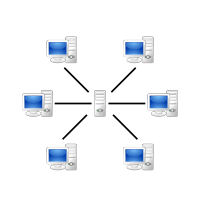User talk:Chongzhihongwiki
WebDB & P2P
[edit]We keep asking ourselves, "What can database do for the coming Web 3.0?". Steffen Staab and Heiner Stuckenschmidt said some hints in the preface of their book, "Semantic Web and Peer to Peer".
The Semantic Web and Peer-to-Peer are two technologies that address a common need at different levels:
• The Semantic Web addresses the requirement that one may model, manipulate and query knowledge and information at the conceptual level rather than at the level of some technical implementation. Moreover, it pursues this objective in a way that allows people from all over the world to relate their own view to this conceptual layer. Thus, the Semantic Web brings new degrees of freedom for changing and exchanging the conceptual layer of applications.
• Peer-to-Peer technologies aim at abandoning centralized control in favor of decentralized organization principles. In this objective they bring new degrees of freedom for changing information architectures and exchanging information between different nodes in a network.
• Together, Semantic Web and Peer-to-Peer allow for combined flexibility at the level of information structuring and distribution.
For database, we neeed to say more...
WebDB
[edit]What difference between database and WebDB?
P2P
[edit]licenses).
| This user page may require cleanup to meet Wikipedia's quality standards. No cleanup reason has been specified. Please help improve this user page if you can. |
- For other uses of the term see Peer-to-peer (disambiguation)
- For peer-to-peer networks used for file sharing see File sharing


A peer-to-peer (or P2P) computer network uses diverse connectivity between participants in a network and the cumulative bandwidth of network participants rather than conventional centralized resources where a relatively low number of servers provide the core value to a service or application. P2P networks are typically used for connecting nodes via largely ad hoc connections. Such networks are useful for many purposes. Sharing content files (see file sharing) containing audio, video, data or anything in digital format is very common, and real time data, such as telephony traffic, is also passed using P2P technology.
A pure P2P network does not have the notion of clients or servers but only equal peer nodes that simultaneously function as both "clients" and "servers" to the other nodes on the network. This model of network arrangement differs from the client-server model where communication is usually to and from a central server. A typical example of a file transfer that is not P2P is an FTP server where the client and server programs are quite distinct: the clients initiate the download/uploads, and the servers react to and satisfy these requests.
In contrast to the above discussed pure P2P network, an example of a distributed discussion system that also adopts a client-server model is the Usenet news server system, in which news servers communicate with one another to propagate Usenet news articles over the entire Usenet network. Particularly in the earlier days of Usenet, UUCP was used to extend even beyond the Internet. However, the news server system acted in a client-server form when individual users accessed a local news server to read and post articles. The same consideration applies to SMTP email in the sense that the core email relaying network of Mail transfer agents follows a P2P model while the periphery of e-mail clients and their direct connections is client-server. Tim Berners-Lee's vision for the World Wide Web, as evidenced by his WorldWideWeb editor/browser, was close to a P2P network in that it assumed each user of the web would be an active editor and contributor creating and linking content to form an interlinked "web" of links. This contrasts to the more broadcasting-like structure of the web as it has developed over the years.
Some networks and channels such as Napster, OpenNAP and IRC server channels use a client-server structure for some tasks (e.g. searching) and a P2P structure for others. Networks such as Gnutella or Freenet use a P2P structure for all purposes, and are sometimes referred to as true P2P networks, although Gnutella is greatly facilitated by directory servers that inform peers of the network addresses of other peers.
P2P architecture embodies one of the key technical concepts of the Internet, described in the first Internet Request for Comments, RFC 1, "Host Software" dated April 7, 1969. More recently, the concept has achieved recognition in the general public in the context of the absence of central indexing servers in architectures used for exchanging multimedia files.
The concept of P2P is increasingly evolving to an expanded usage as the relational dynamic active in distributed networks, i.e. not just computer to computer, but human to human. Yochai Benkler has coined the term "commons-based peer production" to denote collaborative projects such as free software. Associated with peer production are the concept of peer governance (referring to the manner in which peer production projects are managed) and peer property (referring to the new type of licenses which recognize individual authorship but not exclusive property rights, such as the GNU General Public License and the Creative Commons
Streamlizing Algorithms
[edit]As opposed to persistent data stored in memory medium for accessed on demand, transient data originated on line stream by if not explicitly stored. These transient data, called data streams, invalid many existing algorithms for persistent data. Paralleled with persistent data and data streams, streaming algorithms is coined which process streams with sublinear memory cost. Among many methods of designing algorithms for data streams, "streamlizing" algorithms to enable algorithms to process data streams is a possible research direction.
External Links: [WebDB.cn@Southeast University http://sites.google.com/site/webdbp2p/]
